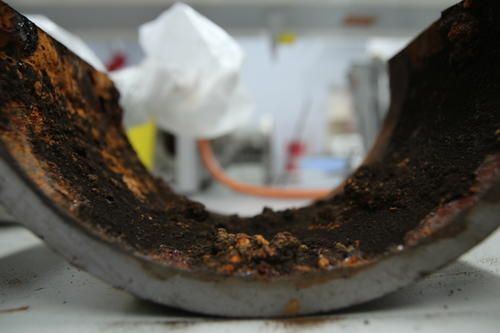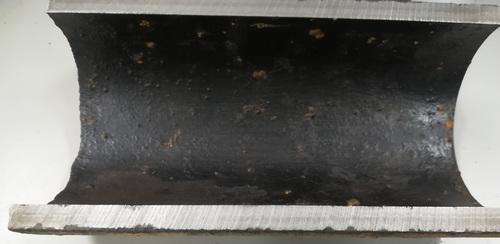You probably never think about it when you turn on the tap for some water, to make coffee for example, what is needed to get that water to your residence. Vitens is a company that ensures that no less than 5.7 million people in the Netherlands are supplied with clean drinking water every day. Every year the company supplies more than 330 million m3 of water via a network of pipelines with an impressive length of 49,600 km. Try to imagine this for a moment, that is longer than the circumference of the earth! Maintaining such a network is quite a challenging job.
A part of the Vitens pipeline network is made of cast iron. To get an assessment of the conditions of these pipes, Vitens asked us to examine the cast iron pipes for microbiologically influenced corrosion (MIC). The company would like to know if there are microorganisms present in the pipes that can cause MIC corrosion and whether they are active. In addition, Vitens wants to know which factors increase the risk of MIC corrosion. As a result, Vitens wants to formulate a mitigation plan to limit damage caused by MIC corrosion as much as possible.
There may be several factors causing the formation of MIC corrosion, such as the amount of nutrients in the water, the flow rate and acidity of the water and the material from which the pipes are made. The production steps used to purify the water could also promote or inhibit MIC corrosion. In order to assess the effects of these factors on MIC processes, eight cast iron piping sections of four different treatment sites have been examined, taking into account all of the above factors.


MIC corrosion related microorganisms have been found in all the pipelines examined. However, there are striking differences in the degree of damage. Two out of eight pipelines were barely affected by corrosion defects, unlike the six others. The question is: What is the explanation for these differences?
The study shows that the differences in water quality, purification steps and water flow rates do not directly affect the amount of damage caused by MIC corrosion. For example, when looking at water quality, the measurements for all the researched locations show that there is a sufficient supply of nutrients available to create MIC corrosion in all the pipes.
Something that seemed to affect the degree of the defects was a black layer on the inside of the pipes. This layer was found on the two pipes that hardly had any corrosion damage, but was not found on the other six. Research into this black layer revealed that it is a coating that probably contains bitumen, a material that was widely used in drinking water distribution pipelines up to the 1990s.
The conclusion of the investigation is that the cast iron pipelines that were examined are all contaminated with active MIC microorganisms. In unprotected pipes - without a coating- this leads to corrosion defects. The pipelines containing an intact coating are protected against these active MIC microorganisms and are therefore less affected by corrosion.
That is why it is important to determine the presence of a coating within other cast iron pipelines. A risk map can then be drawn for pipes with lower or higher risk of failure. Based on this, Vitens can maintain the pipeline network much more efficiently and in a more targeted way.

Are you interested in this topic and would you like more information? Please contact Elsemiek Croese,
croese@microbialanalysis.com

Jentina Schuurman, Project Leader Vitens Laboratory
“Vitens wanted more insight into the quality and current status of the pipeline network. We asked Microbial Analysis to determine whether the cast iron pipes in the Vitens pipeline network are affected by (active) MIC and whether action is required. Thanks to this research, we have gained insight into the situation with regard to MIC corrosion in our pipelines and the status of cast iron pipelines at several locations in the network. Based on these initial results, it was suspected that an internal coating- found in some of the pipelines- ensures that the quality of these pipelines is considerably better, which causes the degree of MIC and corrosion to be far less compared to pipelines without coating. This has been confirmed in a follow-up study, which has given Vitens more insight into the risk of failure of these types of pipelines.
It was a very pleasant experience to work with Microbial Analysis. Considerable attention was paid to mapping our question, so we could develop thorough research questions and draw clear conclusions. Questions about the report were answered quickly and correctly. Furthermore, Microbial Analysis was closely involved in our consideration of the next steps to be taken”.